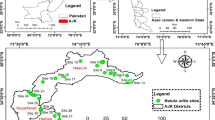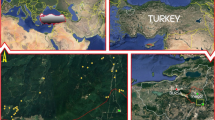Abstract
The response of diversity and biomass of herbaceous functional groups along an altitudinal gradient in mountainous forests of southern Zagros, Khuzestan Province, Iran was studied by sampling vegetation in 30 circular 1000-m2 plots in herb layer of the forest floor within 646–2447 m asl (lowland: < 1000 m asl, midland: 1000–2000 m asl, highland: > 2000 m asl). The most important herbaceous functional groups were classified based on two aspects of growth form: annuals–perennials, grasses–forbs. Then the relationship between the diversity, richness, evenness, biomass and elevation was analyzed. The results showed that the annual functional group in the low- and midland classes, and perennial functional group in the lowland class had the highest species diversity and evenness in annual and perennial functional groups, respectively (p < 0.01). The perennials in the highland class had the maximum total, above- and belowground dry biomass (p < 0.01). On the other hand, the forb functional group in the lowland class had the greatest species diversity, richness, and evenness (p < 0.01) and in the highland class had the maximum total dry, above- and belowground dry biomass in the grass and forb functional groups (p < 0.01). Increasing the diversity, richness, and species evenness resulted in a decrease in the plant dry biomass.




Similar content being viewed by others
References
Abella SR, Smith SD (2013) Annual–perennial plant relationships and species selection for desert restoration. J Arid Land 5(3):298–309
Alhamad N (2006) Ecological and species diversity of arid Mediterranean grazing land vegetation. J Arid Environ 66:698–715
Bai F, Sang W, Axmacher JC (2011) Forest vegetation responses to climate and environmental change: a case study from Changbai Mountain, NE China. For Ecol Manag 262:2052–2060
Burke A (2001) Classification and ordination of plant communities of the Nauklaft Mountain, Namibia. J Veg Sci 12:53–60
Chawla A, Rajkumar S, Singh KN, Lal B, Singh RD, Thukral AK (2008) Plant species diversity along an altitudinal gradient of Bhabha Valley in Western Himalaya. J Mount Sci 5:157–177
Chiarucci A, Rocchini D, Leonzio C, De Dominicis V (2001) A test of vegetation–environment relationship in serpentine soils of Tuscany, Italy. Ecol Res 16(4):627–639
Cornelissen JHC, Lavorel S, Garnier E, Dıaz S, Buchmann N, Gurvich DE, Reich PD (2003) Handbook of protocols for standard and easy measurement of plant functional traits worldwide. Aust J Bot 51:335–380
Dinarvand M, Ejtehadi H, Farzam M, Andarzian B (2016) Investigating the effect of environmental factors on biodiversity and modeling the effect of climate change on some plant species in the Shimbar conservation area, Khuzestan province, state thesis—science, research, and technology ministry. Ferdowsi Mashhad University-Faculty of Sciences, p 133
Ensslin A, Rutten G, Pommer U, Zimmermann R, Hemp A, Fischer M (2015) Effects of elevation and land use on the biomass of trees, shrubs and herbs at Mount Kilimanjaro. Ecosphere 6(3):1–15
Faraji F, Mahtaji A, BabaeiKafaki S, Vahedi V (2015) The relationship between plant diversity and changes in aboveground biomass in eastern Rush Forests (case study: Hajikal–Tirankeli, Sari). Iran For J 7(2):151–165 (in Persian)
Franks AJ, Yates CJ, Hobbs RJ (2009) Defining plant functional groups to guide rare plant management. Plant Ecol 204(2):207–216
Grytnes JA, Beaman JH (2006) Elevation species richness patterns for vascular plants on Mount Kinabalu, Borneo. J Biogeogr 33:1838–1849
Hai-Bao R, Shu-Kui N, Lin-Yan Z, Ke-Ping M (2006) Distribution of vascular plant species richness along an elevation gradient in the dangling Mountains. Int Plant Biol 48(2):153–160
Heydari M, Atar RS, Hatami K (2010) Evaluating biodiversity of herbaceous plants in relation with physiographic factors in forest ecosystems of middle Zagros–Dalab Conservation Area. J Renew Nat Resour Res 1(2):28–41 (in Persian)
Hooper DU, Vitousek PM (1997) The effects of plant composition and diversity on ecosystem processes. Science 277:1302–1305
Husch B, Beers TW, Kershaw JA (2002) Forest mensuration. Wiley, London, p 143
Kelly CK, Bowler MG (2002) Coexistence and relative abundance in forest trees. Nature 417:437–440
Kerns BK, Ohmann JL (2004) Evaluation and prediction of shrub cover in coastal Oregon forests (USA). Ecol Ind 4:83–98
Lavorel S, Garnier E (2002) Predicting changes in community composition and ecosystem functioning from plant traits: revisiting the Holy Grail. Funct Ecol 16:545–556
Li JH, Zhang JH, Li WJ, Xu DH, Knops JMH, Du GZ (2016) Plant functional groups, grasses versus forbs, differ in their impact on soil carbon dynamics with nitrogen fertilization. Eur J Soil Biol 75:79–87
McVicar TR, Korner C (2013) On the use of elevation, altitude, and height in the ecological and climatological literature. Oecologia 171(2):335–337
Meng D, Zhang JT, Li M (2012) Diversity of woodland communities and plant species along an altitudinal gradient in the Guancen Mountains, China. Sci World J 32:12–21
Mirzaei J, Heydari M, Bernard P (2017) Effects of vegetation patterns and environmental factors on woody regeneration in semi-arid oak-dominated forests of western Iran. J Arid Land 9(3):368–378
Monica LP, Roger LS, Tony JS, Richard EE (2004) Plant species diversity in a grassland plant community: evidence for forbs as a critical management consideration. West N Am Nat 64(2):219–230
Morais JM, Cianciaruso MV (2014) Plant functional groups: scientometric analysis focused on removal experimentsPlant functional groups: scientometric analysis focused on removal experiments. Acta Bot Bras 28(4):502–511
Muller RA, Oberlande TM (1978) Physical geography today, a portrait of a planet. McGraw-Hill College, Subsequent edition, 591 pp
Namgail T, Rawat GS, Mishra C, Wieren SE, Prins HH (2012) Biomass and diversity of dry alpine plant communities along altitudinal gradients in the Himalayas. J Plant Res 125(1):93–101
Nico E, Alexander CWS, Stefan S (2011) Collembola species composition and diversity effects on ecosystem functioning vary with plant functional group identity. Soil Biol Biochem 43:1697–1704
Nilsson MC, Wardle A (2005) Understory vegetation as a forest ecosystem driver: evidence from the northern Swedish boreal forest. Front Ecol Environ 3:421–428
Olff H, Ritchie ME, Prins HH (2002) Global environmental controls of diversity in large herbivores. Nature 415:901–904
Panayiotis T, Panitsa M, Tsiftsis S (2013) Elevational gradient of vascular plant species richness and endemism in crete—the effect of post-isolation mountain uplift on a continental island system. PLoS ONE 8(3):e59425
Poorter L, Bongers L, Bongers F (2006) Architecture of 54 moist-forest tree species: traits, trade-offs, and functional groups. Ecol 87:1289–1301
QASEC (QatrAbsazeh Engineering Company) (2009) The meteorological report of sustainable descriptive-executive studies of natural resources and watershed management of Dareh-Anari-Baghmalek watershed, p 78
Reich PB, Tilman D, Naeem S, Ellsworth DS, Knops J, Craine J, Wedin D, Trost J (2004) Species and functional group diversity independently influence biomass accumulation and its response to CO2 and N. Proc Natl Acad Sci USA 101(27):10101–10106
Ricklefs RE (2004) A comprehensive framework for global patterns in biodiversity. Ecol Lett 7:1–15
Rosas P, Schepers J, Wichmann FA, Wagemans J (2002) Surface-slant and surface-curvature from texture. Perception 31:S27a
Salunkhea O, Kharea PK, Gwalwanshia DR, Uniyalb S (2014) Biomass estimation from herb, shrub and litter component of tropical dry deciduous forest of Madhya Pradesh state of India. J Ecol 109:358–362
Sánchez-Gonzalez A, Lopez-Mata L (2005) Plant species richness and diversity along an altitudinal gradient in the Sierra Nevada, Mexico. Bio Res 11:567–575
Schmidt I, Zerbe S, Betzin J, Weckesser M (2006) An approach to the identification of indicators for forest biodiversity—the solling Mountains (NW Germany) as an example. Rest Ecol 14(1):123–136
Soethe N, Lehmann J, Engels C (2008) Nutrient availability at different altitudes in a tropical montane forest in Ecuador. J Trop Ecol 24(4):397–406
Suchar VA, Crookston NL (2010) Understory cover and biomass indices predictions for forest ecosystems of the Northwestern United States. Ecol Ind 10:602–609
Sutherland WJ, Freckleton RP, Godfray HCJ, Beissinger SR, Benton T, Cameron DD, Carmel Y, Coomes DA, Coulson T, Emmerson MC, Hails RS, Hays GC, Hodgson DJ, Hutchings MJ (2013) Identification of 100 fundamental ecological questions. J Ecol 101:58–67
Taleshi H, Babarabi MM (2013) Leaf morphological variation of Quercus brantii Lindl. along an altitudinal gradient in Zagros forests of Fars Province, Iran. Eur J Exp Biol 3(5):463–468
Vockenhuber EA, Scherber C, Langenbruch C, Meibner M, Seidel D, Tschantke T (2011) Tree diversity and environmental context predict herb species richness and cover in Germanys largest connected deciduous forest. Persp Plant Ecol 13:111–119
Wang GH, Zhou GS, Yang LM, Li ZQ (2003) Distribution, species diversity and life form spectra of plant communities along an altitudinal gradient in the northern slopes of Qilianshan Mountains, Gansu, China. Plant Ecol 165(2):169–181
Wang C, Cao G, Wang Q, Jing Z, Ding L, Long R (2008) Changes in plant biomass and species composition of alpine Kobresia meadows long altitudinal gradient on the Qinghai-Tibetan Plateau. Sci China Ser C Life Sci 15(1):86–94
Wright JP, Naeem S, Hector A, Lehman C, Reich PB, Schmid B, Tilman D (2006) conventional functional classification schemes underestimate the relationship with ecosystem functioning. Ecol Lett 9:111–120
Yu M, Sun OJ (2013) Effects of forest patch type and site on herb-layer vegetation in a temperate forest ecosystem. For Ecol Manag 300:14–20
Zhang JT, Zhang F (2007) Diversity and composition of plant functional groups in mountain forests of the Lishan Nature Reserve, North China. Bot Stud 48:339–348
Author information
Authors and Affiliations
Corresponding author
Additional information
Publisher's Note
Springer Nature remains neutral with regard to jurisdictional claims in published maps and institutional affiliations.
Project funding: The funding of project is supported by Lorestan University, Iran.
The online version is available at http://www.springerlink.com
Corresponding editor: Chai Ruihai.
Rights and permissions
About this article
Cite this article
Shahriari, H., Abrari Vajari, K., Pilehvar, B. et al. Diversity and biomass of different functional groups of herbaceous species along an altitudinal gradient in the semi-arid Zagros mountain forests of Iran. J. For. Res. 31, 1723–1731 (2020). https://doi.org/10.1007/s11676-019-00947-4
Received:
Accepted:
Published:
Issue Date:
DOI: https://doi.org/10.1007/s11676-019-00947-4




